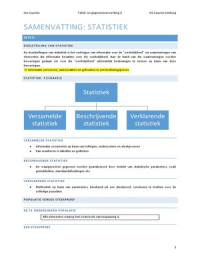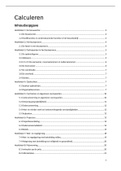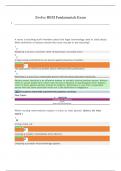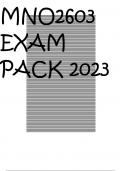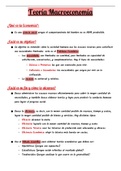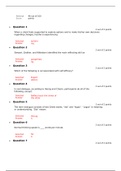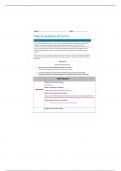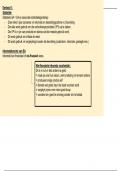Yoder-Wise's Leading and Managing in Canadian Nursing
Patricia S. Yoder-Wise, Janice Waddell, and Nancy Walton
2nd Edition Table of Contents
Chapter 01 Leading, Managing, and Following 1
Chapter 02 Developing the Role of Leader 13
Chapter 03 Developing the Role of Manager 21
Chapter 04 Nursing Leadership in Indigenous Health 31
Chapter 05 Patient Focus 37
Chapter 06 Ethical Issues 46
Chapter 07 Legal Issues 53
Chapter 08 Making Decisions and Solving Problems 62
Chapter 09 Health Care Organizations 72
Chapter 10 Understanding and Designing Organizational Structures 80
Chapter 11 Cultural Diversity in Health Care 89
Chapter 12 Power, Politics, and Influence 98
Chapter 13 Caring and Communicating in Nursing With Technology 107
Chapter 14 Managing Costs and Budgets 114
Chapter 15 Care Delivery Strategies 125
Chapter 16 Staffing and Scheduling 135
Chapter 17 Selecting, Developing, and Evaluating Staff 144
Chapter 18 Strategic Planning and Goal Setting 154
Chapter 19 Nursing Leading Change A Relational Emancipatory Framework for Health and Social 163
Chapter 20 Building Teams Through Communication and Partnerships 172
Chapter 21 Collective Nursing Advocacy 181
Chapter 22 Understanding Quality, Risk, and Safety 192
Chapter 23 Translating Research into Practice 200
Chapter 24 Understanding and Resolving Conflict 210
Chapter 25 Managing Personnel Challenges 219
Chapter 26 Workplace Violence and Incivility 229
Chapter 27 Inter- and Intraprofessional Practice and Leading in Professional Practice Settings 238
Chapter 28 Role Transition 247
Chapter 29 Self-Management Stress and Time 257
Chapter 30 Thriving for the Future 266
Chapter 31 Leading and Managing Your Career 275
Chapter 32 Nursing Students as Leaders 283 https://www.stuvia.com/en-us/user/AllStudyGuidesChapter 01: Leading, Managing, and Following Waddell/Walton: Yoder-Wise’s Leading and Managing i n Canadian Nursing, Second Edition MULTIPLE CHOICE 1. A nurse manager of a 20-bed medical unit finds that 80% of the patients are older adults. She is asked to assess and adapt the unit to better meet the unique needs of older adult patients. According to complexity principles, what would be the best approach to take in making this change? a. Leverage the hierarchical management position to get unit staff involved in assessment and planning. b. Engage involved staff at all levels in the decision -making process. c. Focus the assessment on the unit, and omit the h ospital and community environment. d. Hire a geriatric specialist to oversee and control the project. ANS: B Complexity theory suggests that systems interact an d adapt and that decision making occurs throughout the systems, as opposed to being held in a hierarchy. In complexity theory, everybody’s opinion counts; therefore, all levels o f staff would be involved in decision making. DIF: Cognitive Level: Apply REF: Page 14 TOP: Nursing Process: Implementation 2. A unit manager of a 25-bed medical/surgical are a receives a phone call from a nurse who has called in sick five times in the past month. He tells the manager that he very much wants to come to work when scheduled, but must often care for his wife, who is undergoing treatment for breast cancer. In the practice of a s trengths-based nursing leader, what would be the best approach to satisfying the needs of thi s nurse, other staff, and patients? a. Line up agency nurses who can be called in to work on short notice. b. Place the nurse on unpaid leave for the remainder o f his wife’s treatment. c. Sympathize with the nurse’s dilemma and let the charge nurse know that this nurse may be calling in frequently in the future. d. Work with the nurse, staffing office, and other nurses to arrange his scheduled days off around his wife’s treatments. ANS: D Placing the nurse on unpaid leave may threaten phys iologic needs and demotivate the nurse. Unsatisfactory coverage of shifts on short notice c ould affect patient care and threaten staff members’ sense of competence. Strengths-based nurse leaders honour the uniqueness of individuals, teams, systems, and organizations; the refore arranging the schedule around the wife’s needs would result in a win-win situation, a lso creating a work environment that promotes the health of all the nurses and facilitat es their development. DIF: Cognitive Level: Analyze REF: Page 6 TOP: Nursing Process: Implementation ______________________________________________________________________________________________
______________________________________________________________________________________________Test Bank - Yoder-Wise's Leading and Managing in Canadian Nursing, 2nd Edition (Waddell, 2020)
1 | P a g e https://www.stuvia.com/en-us/user/AllStudyGuides 3. A grievance brought by a staff nurse against th e unit manager requires mediation. At the first mediation session, the staff nurse repeatedly calls the unit manager’s actions unfair, and the unit manager continues to reiterate the reasons for the actions. What would be the best course of action at this time? a. Send the two disputants away to reach their own res olution. b. Involve another staff nurse in the dis cussion so as to clarify issues. c. Ask each party to examine her own motives and issue s in the conflict. d. Continue to listen as the parties repeat their t houghts and feelings about the conflict. ANS: C Nurses and leaders must assess each situation as un ique, determining appropriate actions accordingly. Leaders must adapt their styles to com plement specific issues being faced, such as conflict. Examining motives and issues for the c onflict in perceptions promotes equal representation of each point of view. DIF: Cognitive Level: Apply REF: Pages 11–13 TOP: Nursing Process: Implementation 4. Shortly after being informed of fetal death, a labouring woman asks why she is not able to hear her baby’s heartbeat on the monitor anymore. A lthough the monitor volume had been turned off so that the patient would be able to sle ep between contractions, the nurse responded that there was no heartbeat to hear becau se the baby had died in utero; then the nurse asked whether the patient would like to talk about how she was feeling. This response demonstrates: a. Lack of emp athy. b. Ethical leadership. c. Complexity science. d. A coercive relationship. ANS: B Ethical leadership is based on a willingness to ide ntify and act on complex problems in an ethical manner. Leadership can be misused when coer cive relationships form, and information and true goals are withheld. DIF: Cognitive Level: Analyze REF: Page 7 TOP: Nursing Process: Implementation 5. The manager of a surgical area envisions a futu re that requires the addition of registered nurse (RN) assistants or unlicensed persons to feed , bathe, and walk patients. The RNs on the staff have always practiced in a primary nursin g-delivery system and are very resistant to this idea. The best initial strategy in this sit uation would include: a. Exploring the values of the RNs in relation to this change. b. Leaving the RNs alone for a time so they can thi nk about the change before they are approached again. c. Dropping the idea and trying for the change in anot her year or so. d. Hiring the assistants and allowing the RNs to see w hat good additions they are. ANS: A ______________________________________________________________________________________________
______________________________________________________________________________________________Test Bank - Yoder-Wise's Leading and Managing in Canadian Nursing, 2nd Edition (Waddell, 2020)
2 | P a g e https://www.stuvia.com/en-us/user/AllStudyGuidesLeadership involves engaged decision making around a vision that is based on evidence and tacit knowledge. Influencing others requires emotio nal intelligence in domains such as empathy and handling relationships. DIF: Cognitive Level: Apply REF: Page 5 TOP: Nursing Process: Implementation 6. As the charge nurse on the night shift in a sma ll long-term care facility, you have found that there is little turnover among your licensed practi cal nurse and nursing assistant (NA) staff members, but they are not very motivated to work be yond their job descriptions. Which of the following strategies might motivate the staff a nd lead to greater job satisfaction? a. Ask the director of nursing to offer higher wage s and bonuses for extra work for the night licensed practical nurses and NAs. b. Allow the licensed practical nurses and NAs grea ter decision-making power within the scope of their positions in the institution. c. Help the licensed practical nurses and NAs with the ir work, whenever possible. d. Ask the director of nursing to increase job secu rity for night staff by having them sign contracts that guarantee work. ANS: B A nurse leader should provide an environment conduc ive to opinion sharing that involves staff in decision making at all levels. This approa ch is shown to increase job satisfaction. Decision making and the corresponding actions taken are core tasks performed in engagement with coworkers. DIF: Cognitive Level: Apply REF: Page 7 TOP: Nursing Process: Implementation 7. As the nurse manager, you want to increase moti vation by providing motivating factors. Which action would you select? a. Collaborate with the human resources/personnel d epartment to develop on-site daycare services. b. Provide a hierarchical organizational structure. c. Implement a model of shared governance. d. Promote the development of a flexible benefits pack age. ANS: C Complexity theory suggests that systems interact an d adapt and that decision making occurs throughout systems, as opposed to being made unilat erally by different levels of the organizational hierarchy. In complexity theory, eve ry person’s opinion counts, and therefore all levels of staff would be involved in decision m aking. This principle underlies shared governance. Shared governance is an example of nurs e decision making in which nurses at different organizational levels engage in shaping p olicy and practices. DIF: Cognitive Level: Apply REF: Page 5 TOP: Nursing Process: Implementation ______________________________________________________________________________________________
______________________________________________________________________________________________Test Bank - Yoder-Wise's Leading and Managing in Canadian Nursing, 2nd Edition (Waddell, 2020)
3 | P a g e https://www.stuvia.com/en-us/user/AllStudyGuides 8. A charge nurse on a busy 40-bed medical/surgica l unit is approached by a patient’s son, who begins to complain loudly about the quality of care his mother is receiving. His behaviour is so disruptive that it is overheard by staff, physic ians, and other visitors. The family member rejects any attempt to intervene therapeutically to resolve the issue. He leaves the unit abruptly, and the nurse is left feeling frustrated. Which behaviour by the charge nurse best illustrates refined leadership skills in an emotion ally intelligent practitioner? a. Reflection to obtain insight into how the situat ion could be handled differently in the future b. Trying to catch up with the angry family member to resolve the concern c. Discussing the concern with the patient after the f amily member has left d. Notifying nursing administration of the situation ANS: A Emotional intelligence is closely aligned with indi viduals’ capacity to know themselves and others. Reflecting to obtain insight and being able to “step” outside the situation to envision the context of what is happening is an example of t he actions of an emotionally intelligent practitioner. DIF: Cognitive Level: Apply REF: Page 8 TOP: Nursing Process: Implementation 9. The chief nursing officer has asked the staff d evelopment coordinator to facilitate the development of a clinical competency program for th e facility. While making rounds on the units, the staff development coordinator overhears RN staff complaining that they believe it is insulting to be required to participate in a com petency program. Which behaviour by the staff development coordinator is most appropriate i n this situation? a. Disregard staff concerns and continue with developm ent of the program. b. Inform the nurses that this program is a require ment for accreditation by the Joint Commission on Accreditation of Healthcare Organizat ions (JCAHO). c. Schedule a meeting with the chief nurse executive t o apprise her of the situation. d. Facilitate a meeting so nurses can articulate th eir values and concerns about a competency program. ANS: D The manager role involves guiding other people thro ugh a set of derived practices that are evidence-informed and known to satisfy pre-establis hed outcomes such as participation in a competency program. This involves engagement of sta ff through sharing of concerns and ideas. This type of leader can instill hope and tru st in followers, which influence their behaviours and attitudes (such as engagement and sa tisfaction) and cause work environments to become more positive. DIF: Cognitive Level: Apply REF: Pages 11–13 TOP: Nursing Process: Implementation 10. Which category is unique to leadership but is not part of management? a. Initiating change b. Personal qualities c. Developing people d. Information management ANS: C ______________________________________________________________________________________________
______________________________________________________________________________________________Test Bank - Yoder-Wise's Leading and Managing in Canadian Nursing, 2nd Edition (Waddell, 2020)
4 | P a g e https://www.stuvia.com/en-us/user/AllStudyGuidesDeveloping people—coaching, mentoring, succession p lanning—is a category of solely leadership, not management. Initiating change and p ersonal qualities are categories of both management and leadership. Information management i s a category of management only. DIF: Cognitive Level: Understand REF: Page 17 TOP: Nursing Process: Assessment 11. You overhear a newly graduated RN telling one of your colleagues that leadership and management belong to the unit manager and not to he r. Because you are a nursing colleague, your response demonstrates understanding that the perception of the new graduate: a. Is accurately reflected in the new graduate’s state ment. b. Would benefit from further understanding of her role as a professional in relation to decision -making. c. Has been influenced by nurse leaders and managers w ho leave for other positions. d. Is related to the general perception that nurse leaders and managers are not satisfied in their jobs. ANS: B Decision making and the corresponding actions taken are the core work performed in engagement with co-workers. This core work requires that nurses be leaders, managers, and followers at the point-of-care, unit, institutional , and even societal levels. DIF: Cognitive Level: Understand REF: Page 7 TOP: Nursing Process: Evaluation 12. You walk into a patient’s room and find him ye lling at the licensed practical nurse. The patient is obviously very upset, and after you spea k with him regarding his behaviour, you determine that he has not slept for three nights be cause of unrelieved pain levels. The licensed practical nurse is very upset with him and calls him an “ugly, old man.” You acknowledge her feelings and concerns and then sugg est that the patient’s behaviour was aggressive but is related to lack of sleep and to p ain. You ask, “Can both you and the patient together determine triggers for the pain and effect ive approaches to controlling his pain?” This approach demonstrates: a. Lack of empathy and understanding for the licensed practical nurse. b. Concern with placating the patient. c. Leadership behaviour. d. Management behaviour. ANS: C The situation between the patient and the licensed practical nurse is complex, involving unrelieved symptoms and aggressiveness toward a sta ff member. Health care is now delivered in a collaborative, and most often, an in terdisciplinary manner, whereby select leadership/management roles (e.g., first-line nurse leaders) serve as conduits for information and care coordination. Providing engaged, collabora tive guidance and decision making in a complex situation for which there is no standardize d solution reflects leadership. DIF: Cognitive Level: Apply REF: Page 7 TOP: Nursing Process: Implementation 13. Which category is unique to management but is not part of leadership? ______________________________________________________________________________________________
______________________________________________________________________________________________Test Bank - Yoder-Wise's Leading and Managing in Canadian Nursing, 2nd Edition (Waddell, 2020)
5 | P a g e https://www.stuvia.com/en-us/user/AllStudyGuidesa. Initiating change b. Personal qualities c. Developing people d. Information management ANS: D Information management is a category of management only. Developing people is a category of solely leadership, not management. Init iating change and personal qualities are categories of both management and leadership. DIF: Cognitive Level: Understand REF: Page 15 TOP: Nursing Process: Assessment 14. Chart audits have revealed significant omissio ns of data that could have legal and funding guidelines. As the unit manager, you meet with the staff to discuss audit findings and to find approaches that will address the gaps in charting a nd achieve desired goals. This is an example of: a. Leadership. b. Management. c. Decision making. d. Vision. ANS: B The process of guiding other people to meet establi shed goals, outcomes, and procedures is management. This can require collaborative decision making to determine how best to reach predetermined goals and follow established practice s. DIF: Cognitive Level: Apply REF: Pages 6–7 TOP: Nursing Process: Implementation 15. A family is keeping vigil at a critically ill patient’s bedside. Other distant family members, not yet able to come, call the unit continuously, a sking for updates and wanting to express concern. You speak with the distant family members and suggest that you are going to refer them to the hospital social worker, whose role is t o work with such situations. What role are you assuming through this action? a. Manager b. Leader c. Follower d. Laissez faire ANS: A Management is the process of getting the job done a nd ensuring that people have the necessary resources to get the job done. Referral t o a social worker alleviates demand on nurse staff time and is consistent with hospital pr ocedures. DIF: Cognitive Level: Apply REF: Page 6 TOP: Nursing Process: Implementation 16. After a meeting with members of the family of a dying patient, the nursing manager discusses with you the family’s desired approach to care, and you support the manager’s decision. Your actions indicate that you are acting in what role? ______________________________________________________________________________________________
______________________________________________________________________________________________Test Bank - Yoder-Wise's Leading and Managing in Canadian Nursing, 2nd Edition (Waddell, 2020)
6 | P a g e https://www.stuvia.com/en-us/user/AllStudyGuidesa. Leadership b. Management c. Followership d. Evidence -informed ANS: C Followership is engaging with other people who are leading or managing by contributing to the work that needs to be done. By accepting and im plementing the desired approach to care direction given by the manager in response to your concerns, you are demonstrating followership. DIF: Cognitive Level: Analyze REF: Page 7 TOP: Nursing Process: Implementation 17. You pull staff together to assess a situation in which the family of a seriously ill patient is anxious and is absorbing a great deal of staff time in consultation, discussion, and questioning of treatment decisions. Staff members a re beginning to distance themselves from the family. After inviting the concerns of sta ff, you explain that the organization values patient-centred care and suggest that evidence indi cates that acting as an advocate and a listener is helpful to families. You ask the staff for ideas as to strategies that are effectively patient-centred in these situations. In this situat ion, you are taking on which role? a. Leadership b. Management c. Follower d. Visionary ANS: A Leadership is the process of engaging and influenci ng others. Strong leaders are associated with words such as visionary, energetic, inspirational, and innovative; they go beyond the status quo to make a difference for others. As a le ader, you engage other people in decision making that moves them toward a goal with a reasona ble level of risk taking. DIF: Cognitive Level: Apply REF: Page 7 TOP: Nursing Process: Implementation 18. Marie-Claire, the nursing unit manager, finds it difficult to work with Thomas, a new graduate. Thomas has many ideas and his manner of p resenting them irks Marie-Claire. After reflection and discussion with others, Marie- Claire recognizes that she also feels threatened by his behaviour. She comes to understan d that Thomas is trying to establish his own role on the unit, is not trying to challenge he r, and needs guidance, coaching, and affirmation. Marie-Claire is demonstrating a. A positive self -concept. b. Deepening self -awareness. c. Leadership. d. Acquiescence. ANS: B Individuals demonstrate emotional intelligence by r aising their self-awareness and better regulating their emotions. Being empathetic and sho wing sensitivity to the experiences of others help nurse leaders develop their emotional i ntelligence. ______________________________________________________________________________________________
______________________________________________________________________________________________Test Bank - Yoder-Wise's Leading and Managing in Canadian Nursing, 2nd Edition (Waddell, 2020)
7 | P a g e https://www.stuvia.com/en-us/user/AllStudyGuidesDIF: Cognitive Level: Apply REF: Page 11 TOP: Nursing Process: Implementation 19. As the head of a nursing program, you consiste ntly invite your team to develop ideas about innovations in teaching, community partnerships, an d curriculum design and invite participation in decisions. Many of these ideas hav e been implemented successfully, and your staff members are keen to try other ideas. You are employing ________________ leadership. a. Situational b. Trait -based c. Contingency -based d. Transformational ANS: D Transformational leadership involves attending to t he needs and motives of followers, which results in creativity, improvement, and employee de velopment. DIF: Cognitive Level: Apply REF: Pages 11–12 TOP: Nursing Process: Implementation 20. As a leader on a rehabilitation unit, you enco urage all staff members to see themselves as having a role in decision making and quality care. You see your role as involving particular responsibilities in decision making, but not as a h ierarchal role. This view of decision-making and leadership is consistent with: a. Trait theories. b. Complexity science. c. Situated theory. d. Emotional intelligence. ANS: B Complexity science involves decision making distrib uted among the human assets within an organization, without regard to hierarchy. DIF: Cognitive Level: Understand REF: Page 14 TOP: Nursing Process: Assessment 21. You recently acquired a position as a unit man ager. During your time on the unit, you have formed a strong social network among your staff, ha ve promoted the development of relationships between your staff and workers in oth er areas of the organization, and have formed relationships that generate ideas from patie nt organizations and the local nursing education program. According to complexity science, you are engaging which principle? a. Empowerment. b. Systematic thinking. c. Development of networks. d. Bottom -up interactions. ANS: C According to complexity science, networks evolve ar ound areas of common interest and can respond to problems in creative and novel ways. DIF: Cognitive Level: Apply REF: Page 14 ______________________________________________________________________________________________
______________________________________________________________________________________________Test Bank - Yoder-Wise's Leading and Managing in Canadian Nursing, 2nd Edition (Waddell, 2020)
8 | P a g e

